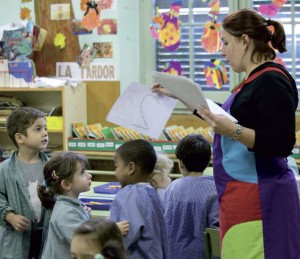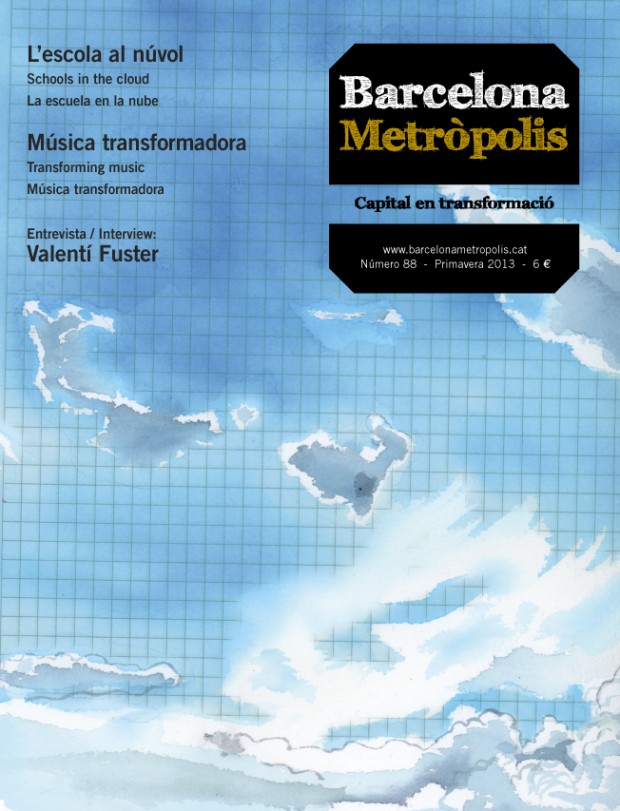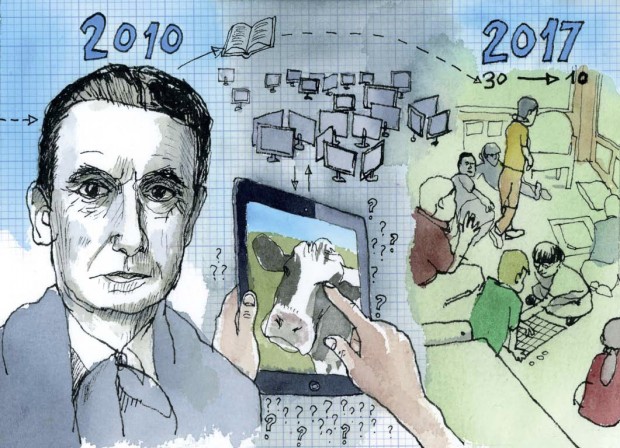What kind of schooling awaits our grandchildren? In the year 2040, this question is answered in an article that takes stock of the educational situation and the changes that have occurred over the previous decades.
(NOTE: This article was published in spring 2013 in a futuristic key)
Thirty years ago (in 2010), the technological boom had peaked, comparable to the technological and real estate “bubbles” of 2000 and 2006, respectively. Nobody could possibly have expected it to collapse like it did. Over this period we have gone from having interactive digital displays in virtually all preschool classrooms to none in 2040. But why were we so easily seduced by technology in the classroom?
This technology fever was brought on by several causes – marketing for schools, hypereducation, the disproportionate concern of our parents (who perhaps suffered from the digital immigrant complex), the trend factor, etc. Were there proper studies that justified such disproportionate spending? No. A chain of events helped to turn what were once known as digital natives into digital emigrants and to usher in the Digital-Free Schooling movement.
The year 2011 brought news of the first school to alight from the tech train, an American Waldorf school, attended by the children of high-ranking executives from technology companies in Silicon Valley. In the wake of this news, “surprising” for those times, books began to spring up telling of the latest scientific findings that questioned the efficacy of the use of screens in early learning, and some even demonstrated their potentially detrimental effects on children. Shortly afterwards, due to the fact that the vast majority of children were discovering the world through a PC display rather than through reality, it transpired that some were seeing reality in 2D; they were living in a flat, shallow world! A loss of the senses of touch and smell through lack of use was also detected. According to a study performed in 2015, any child could identify a cow on a screen, but few knew how they mooed, virtually none knew what they smelt like, and not a single child had ever touched one. Some experts began to talk about two new disorders, “reality deficit” and “humanity deficit”. We know that kids triangulate between the world and the people who teach them. They make their discoveries hand in hand with a real person whom they trust, who helps to give meaning to their learning, something which a screen cannot do. Gaping at a screen that becomes an intermediary between them and reality, children become passive, waiting for the screen to do everything for them. And so their minds wander, their sense of wonder – the engine that powers their desire to learn – is numbed, and their creativity wanes.
At this point one might recall the controversy of 2017, sparked by a group of parents who complained to the Department of Education over the overuse of screens in a subsidised private school. The school alleged that lack of funds, plus the increasing number of learning disorders in children and the number of children per class, rendered it impossible to manage classes without resorting to the use of screens. The controversy, which ended with the school’s licence being withdrawn, sparked a dialogue between science and education that culminated, by popular demand, in the educational reform of 2020, to firstly regulate the use of new technologies in the classroom and secondly revise pupil ratios. The law was visionary as it included the input of hundreds of renowned experts in psychology, neuroscience and pedagogy.
Limitation of the use of new technologies
The reform drew on the recommendations of the experts, who associated poor academic performance and a number of learning disorders with the disproportionate use of screens. Note was taken of the so-called “displacement effect” cited by American literature. While a child is in front of a screen, he or she is losing out on other more “excellent” activities which make a greater contribution to their development, such as reading, playing, rambling, making friends and forging bonds with the people who look after them. Following these recommendations, the reform prohibited, “for reasons of public health”, the use of screens throughout preschool education and permitted it in higher years – in less than 5% of teaching hours – provided that the content and objectives were clearly for learning purposes. Following the legal reform, the use of commercial films in schools was totally prohibited, and decisions on choosing the most suitable contents for children at home were left up to their parents. It had been made clear, once and for all, that school was about education, not recreation. The idea was to make better use of our time so that children would come home with less homework and more time to play, read and be with their parents.
It is significant that this change took place just after the Conciliation Law of 2018, which cut lunch time to half an hour, converting this break into paid time, to allow all workers to finish their working day eight hours after starting it. Now that most parents both get home at the same time as their kids, time spent in front of the screen has diminished drastically, while time spent playing outdoors and playing sports has increased.
During the “2009–2016 crisis”, ratios rose to thirty children per classroom in preschool and primary education. This change, prompted only by short-term and short-sighted cutbacks, was radically revised by the educational reform. Following the recommendations of experts who advocated the importance of the creation of a secure attachment in children’s early years to ensure good development, and who also recommended the application of personalised education in later years, ratios of thirty pupils per class were slashed to ten. Recent longitudinal studies published in indexed journals report benefits across the board for children who were subject to these changes, which are now reaching primary education, and these studies cite our country as a model for the rest of the world.

The educational reform imagined by the author for the year 2020 would ban screens from all infant schools “on public health grounds”. Below, an infants class using traditional methods at Ramon Llull School in Barcelona.
Consequences of the educational reform
A few years after the educational reform, experts reported a reduction in learning disorders, bullying and violence at school. And purely by way of anecdote, the sales of educational books with methods on how to get children to eat, sleep or obey plummeted. The experts hold that this change is due to the fact that most parents spend more time with their children, and are therefore more receptive to their needs, which in turn has a positive impact on their mutual relationships. Parents no longer need the “packaged advice industry”.
Nowadays, owning up to being a digital emigrant is cool. But our generation hasn’t completely emigrated, as more than 50% of parents work from home, via the Internet, so as to be able to attend to their family obligations better. I wonder: might we not be taking our rejection of all things digital a bit too far? The Internet is still a wonderful tool for those who know what they are looking for and what they are not looking for.
In short, we have advanced thirty years, to go sixty back. The difference is that sixty years ago we used to think that progress was synonymous with novelty, while now, we know that novelty may be but an illusion of progress. Progress is the pursuit of excellence, recovering context to connect with beauty and with the wonders of reality. So fortunately, these last sixty years have not elapsed in vain.





Catherine un placer recibir sus articulos, vaya si nos ayudan a pesar y revisar las practicas educativas, la verdad que su libro de educar en el asombro me llamo a querer leerlo ya que estoy leyendo lo que puedo sobre como motivar esa capacidad del hombre tan maltratada en este tiempo como la voluntad, muchas veces he sentido impotencia al ver la capacidad de los ninos y adolescentes que frecuento en mi trabajo docente, pero con la enorme barrera de la falta de voluntad ante lo que implica un poco de sacrificio, o renuncia o tal vez sea descubrir que vale la pena, y que probablemente esa capacidad de asombrarse fue adormecida desde pequeno por todo lo que el mundo de hoy ofrece entre ellos las nuevas tecnologias su uso indiscriminado y cuando no su mal uso. Gracias por compartir sus reflexiones.Monica
Pingback: L’escola. De la crisi a la revolució | Núvol